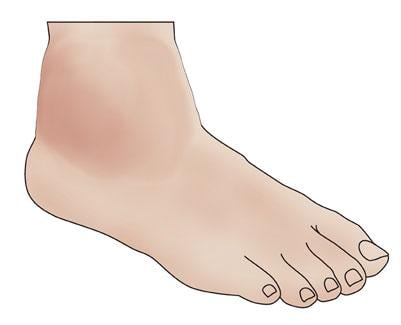Ankle Sprain Treatment, Symptoms, Prevention and Causes
What happens when you sprain your ankle?
An ankle sprain results when your foot turns in on itself. This injury stretches and weakens the ligaments that bridge the ankle and foot bones. Ankle sprains are the most common athletic injuries. The condition is usually defined according to the extent of the damage suffered by the ligament.
A normal ankle joint consists of three bones connected by rubber band-like ligaments. The bones meeting at the ankle joint are called the tibia, fibula and talus. A normal ankle gives us the ability for motion because of power provided by the muscles and tendons surrounding the ankle ligaments. When these ligaments are torn or ruptured, the ankle is "sprained."

Symptoms
What are sprained ankle symptoms?
There are a variety of clear symptoms for ankle sprains, but many of the warning signs vary depending upon the severity of the sprain. These symptoms include:
- Extreme pain
- The inability to put weight on the foot
- Bruising
- Swelling
- General instability
Causes
What causes a sprained ankle?
Usually a sprain occurs from the foot turning inward, stretching or tearing the ligaments on the outside of the ankle. They can occur from jogging, dancing, playing sports, or from inadvertently stepping into a pothole in your street or a depression in your lawn.
- Failure to warm up calf muscles properly before and after exercise
- Poor or worn out shoes or shoes that fit improperly
- Previous ankle injury
- Uneven surfaces
- Obesity
Prevention
How to prevent ankle sprains?
- Before and after exercising, stretch the calf muscles.
- Strengthen the ankles to avoid strains and to rehabilitate them if you have had an injury.
- Try heel walking; wear flat shoes; stand on your heels and keep your toes high off the ground; walk with toes elevated for three to five minutes.
- Follow a regular exercise program.
- When on your feet, especially if you are walking, wear stable shoes that provide support.
- For active sports, most studies suggest wearing snugly laced, high-topped shoes that are protective.
- Avoid platform soles, high heels, and any shoes that throw the foot off balance.
- A healthy diet helps keep muscles strong also assists in ankle sprain prevention.
Treatment
How to treat a sprained ankle?
Conservative treatments for sprained ankle care include basics like rest, ice, compression, and elevation (RICE) of the ankle. Once the leg is stabilized, elevation should take place. When elevating the leg with the sprained ankle, it is important to keep it above the level of your hips whenever possible.
For the first two or three days after the injury, use an ice pack on the sprain as often as possible. Also remember bracing and taping the ankle can make dramatic contributions to the recovery process. If there is no improvement after several days or if swelling and pain are severe, consult a physician.
Wearing proper footwear and shoe inserts, such as heel stabilizers and heel supports, can take stress off of your Achilles' tendons, comfort feet and prevent injuries.
Links to recommended PediFix® Products:





